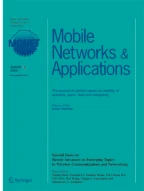Abstract
Mobile phones are becoming pervasively used to access Internet and multimedia contents due to their increasing processing power and its wide range of featured wireless communication technologies (Infrared, Bluetooth, NFC, GSM, UMTS, HSPA, WiMax, LTE). In this paper we also introduce mobile devices as a pervasive testbed platform to characterize the energy consumption profile of Internet services. The most innovative advantage provided by our solution is the testbed’s flexibility and simplicity, making it possible to carry out extensive testing campaigns using actual mobile devices in live networks with real services.
Similar content being viewed by others
Explore related subjects
Discover the latest articles and news from researchers in related subjects, suggested using machine learning.Notes
This tool is oriented to commercial devices, for this reason it is not possible to the verify levels provided by it. But according to 3GPP UMTS Test Specification 25.133, clause 9.1.3, the minimum requirements for absolute accuracy in normal conditions for RSSI measurements are + −6dB. This means that UMTS User Equipment must provide values within that range with a confidence level of 95%. Similarly, the minimum requirements for Absolute Accuracy in measurements of the User Equipment transmitted power, set an allowed range of + −4 dB, as per TS 25.133 clause 9.1.6.
We carried out measurements with different durations; finally, we decided that 9 min measurements were adequate to obtain representative values while keeping a reasonable amount of testing time.
References
Higgs T (2007) Energy efficient computing. In: Proceedings of the 2007 IEEE international symposium on electronics and the environment
Arunkumar N, Srinivasan V (2009) Introduction of new operable modes for battery life optimization in mobile devices. IEEE international advance computing conference, (IACC)
Rahal-Arabi T, Park HJ, Hahn J (2008) Power delivery for the next generation mobile platform. Electrical design of advanced packaging and systems symposium, EDAPS
Zhang T, Madhani S, Gurung P, van den Berg E (2005) Reducing energy consumption on mobile devices with WiFi interfaces. IEEE Globecom
Viredaz MA, Brakmo LS, Hamburgen WR (2003) Energy managment on handheld devices. ACM Queue
Stemn M, Katz RH (1997) Measuring and reducing energy consumption of network interfaces in hand-held devices. Transactions on communications, special issue on mobile computing, vol 8
Viredaz MA, Wallach DA (2003) Power evaluation of a handheld computer. IEEE Micro
Haverinen H, Siren J, Eronen P (2007) Energy consumption of always-on applications in WCDMA networks. In: 65th semi-annual IEEE vehicular technology conference (VTC 2007 Spring)
Diaz A, Merino P (2008) Towards a lightweight middleware for mobile multimedia communication awareness. In: 4th international mobile multimedia communications conference, (MobiMedia2008)
IEEE (2008) Draft standard for local and metropolitan area networks: media independent handover services. Unapproved Draft Std P802.21/D10.0 802.21, IEEE
Mahmud K, Inoue M, Murakami H, Hasegawa M, Morikawa H (2005) Energy consumption measurement of wireless interfaces in multi-service user terminals for heterogeneous wireless networks. IEICE transactions on communications, vol 88, n3
Díaz-Zayas A, Merino P, Panizo L, Recio AM (2007) Experimental analysis of peer-to-peer streaming in cellular networks. In: IEEE 21st international conference on advanced information networking and applications (AINA-07)
Díaz A, Merino P, Panizo L, Recio AM (2007) Evaluating video streaming over GPRS/UMTS networks: a practical case. In: The 65th IEEE vehicular technology conference, VTC 2007-Spring
Arjona A, Yla-JMski A (2007) VoIP call signaling performance and always-on battery consumption in HSDPA, WCDMA and WiFi. International conference on wireless communications, networking and mobile computing (WiCom)
Xiao Y, Sri Kalyanaraman R, Yla-Jaaski A (2008) Energy consumption of mobile YouTube: quantitative measurement and analysis. Conference on next generation mobile applications, services and technologies
Diaz A, Merino P, Rivas FJ (2008) Customer-centric measurements on mobile phones. IEEE international symposium on consumer electronics (ISCE)
Song M, Park K, Kong K-S (2005) Exploiting mobility as context for energy-efficient location-aware computing. Lecture notes in computer science, Springer
Potlapally NR, Ravi S, Raghunathan A, Jha NK (2003) Analyzing the energy consumption of security protocols. In: Proceedings of the 2003 international symposium on low power electronics and design, ISLPED
Kim K, Hong J, Lim J (2006) Analysis of the power consumption of secure communication in wireless networks. Lecture notes in computer science, Springer
De P, Raniwala A, Sharma S, Chiueh T (2005) MiNT: a miniaturized network testbed for mobile wireless research. INFOCOM 2005. 24th Annual joint conference of the IEEE computer and communications societies
Steuer F, Elkotob M, Albayrak S, Steinbach A (2006) Testbed for mobile network operator scenarios. In: 2nd international conference on testbeds and research infrastructures for the development of networks and communities, TRIDENTCOM
Acknowledgements
This work has been funded both by the Spanish government sponsored project TIN 2008-05932 and by project P07-TIC-03131 funded by the Autonomous Community of Andalusia.
Author information
Authors and Affiliations
Corresponding author
Rights and permissions
About this article
Cite this article
Díaz Zayas, A., Merino Gómez, P. A Testbed for Energy Profile Characterization of IP Services in Smartphones over Live Networks. Mobile Netw Appl 15, 330–343 (2010). https://doi.org/10.1007/s11036-010-0228-8
Published:
Issue Date:
DOI: https://doi.org/10.1007/s11036-010-0228-8
